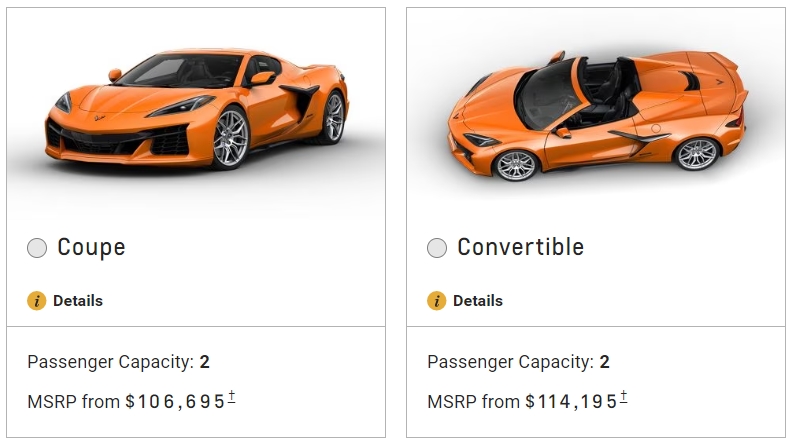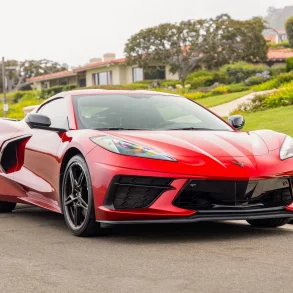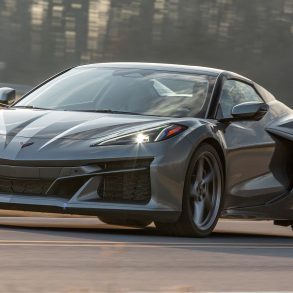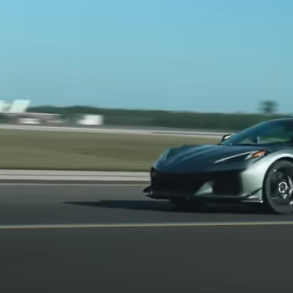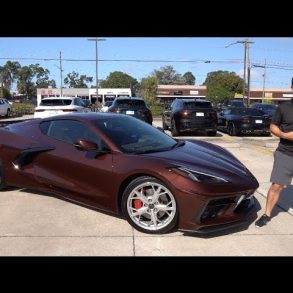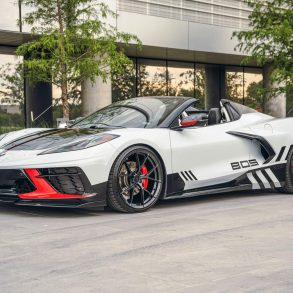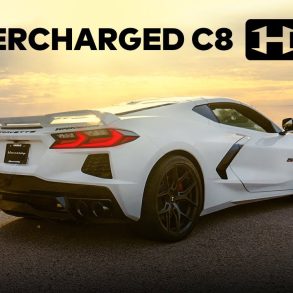2023 C8 Chevrolet Corvette Z06: Overview, VIN, Options, Performance & More
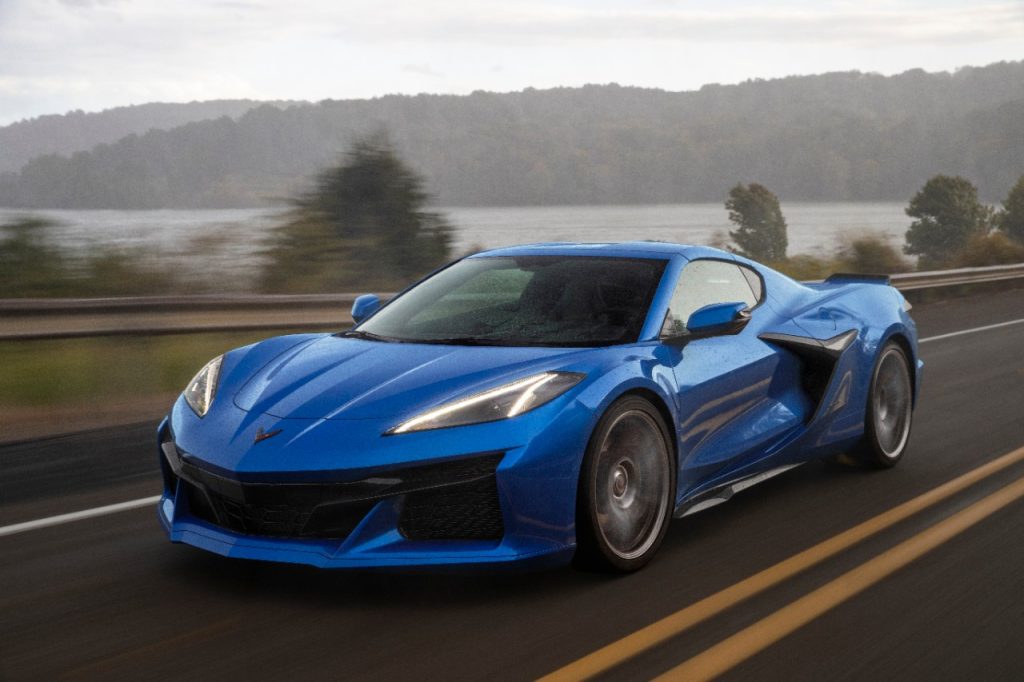
When Chevrolet unveiled the mid-engine Corvette in 2020, the world took notice. The Corvette, which had already become synonymous with serious performance in the American automobile marketplace, had jumped to the next level overnight. For the first time in the brand’s history, Chevrolet had introduced a Corvette that not could not only compete with some of the best European sports cars ever made, but it could now outperform many of them – and at a fraction of the cost. True, the seventh-generation Stingray (in all its iterations) and the sixth-generation Z06 and ZR1 had proved that Chevrolet had the mettle to give brands like Porsche, Ferrari and Lamborghini a run for their money, but the mid-engine platform with its improved acceleration, insanely quick automatic transmission, and its planted, ride-on-rails suspension, had resulted in a car that was equally comfortable on the open road and the race track.
So, when Chevrolet announced that they’d be introducing an eighth-generation Z06 version of their beloved sports car for the 2023 model year, the world waited with immense anticipation at what the team at GM would come up with next. The results, as you are about to discover, transcend sports cars, even supercars, and catapult the Corvette into the realm of the hypercar segment. And no, that’s most definitely NOT hyperbole – but we’ll let the facts speak for themselves.
Let’s begin with the raw data.
Under the “Hood”
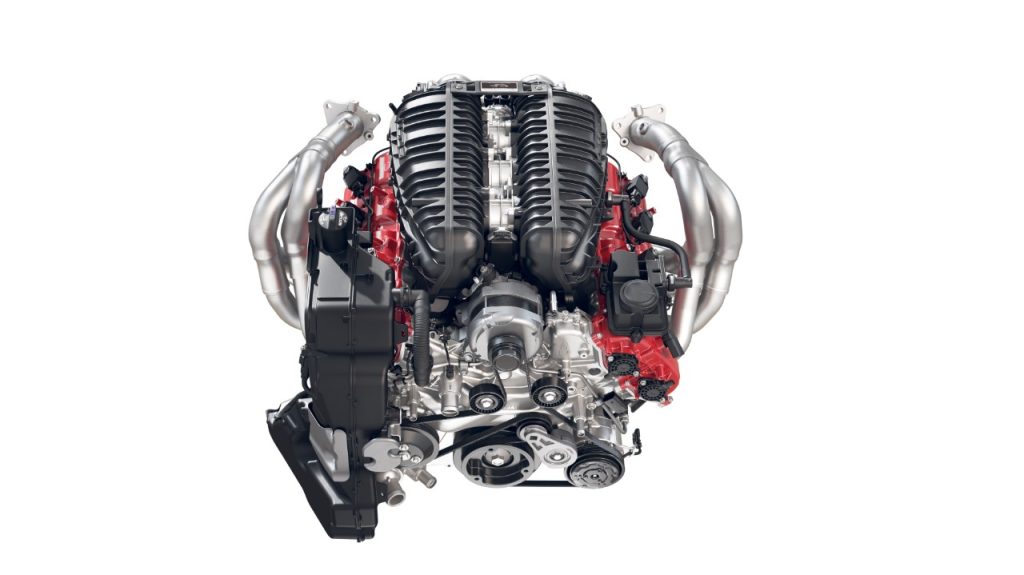
Although we could endlessly expound on just about any aspect of this amazing sports car, we’ll begin by looking at what makes it go. At the heart of the 2023 Corvette Z06 is a naturally aspirated V8 engine boasting 670 horsepower that is capable of propelling the car’s occupants from 0-60 mph in an insanely fast 2.6 seconds. While we’ve heard of other cars doing it faster (Tesla claims their Model X Plaid can achieve a 0-60 time of 2.2 seconds), there just aren’t many other cars at this price point that can deliver that kind of acceleration AND everything else that comes with this package.
We begin with the most powerful naturally aspirated engine ever built. Designated the LT6, this 5.5-liter engine produces twenty more horses than the seventh-generation Z06’s LT4 while weighing approximately thirty pounds less. The LT6 features many of the same components as the LT6.R engine first introduced in the C8.R race car. Both engines share the same cylinder block, heads, valve train, and fuel system designs. The LT6’s block is comprised of a two-piece assembly which includes the upper block casting as well as a lower, all-aluminum crankcase casting (hereby referred to as the LCC). Both the block and the LCC are partially machined, leak-tested, and flow-tested before being permanently bolted together. The block is then bored and honed using a deck plate (the same process used on the race engine) and the engine bearings are hand-selected for optimal clearance.
Chevrolet uses a Precision Sand Cast (CST) process to create both the upper block and the LCC. A liquid polymer resin-cured sand core is used because it offers good core strength, excellent dimensional stability, an excellent surface finish, and design flexibility. Both components are made from a hybrid 319 aluminum alloy and are heated to 1,000°F (538⁰C) for 12 hours and quenched at 150-214°F (66-100°C) as part of the T7 heat treatment. Once cooled, the castings are then aged at 440°F (227°C) for an additional 7-9 hours.
The aluminum LCC is distinctly different from the previous LS and LT engine platforms. Essentially, it is an oil pan mated to the engine’s main caps. Because the LT6 engine utilizes a dry sump system, there is only a minimal amount of oil that collects in the LCC. However, much like a conventional oil pan, the LCC seals off the bottom of the engine.
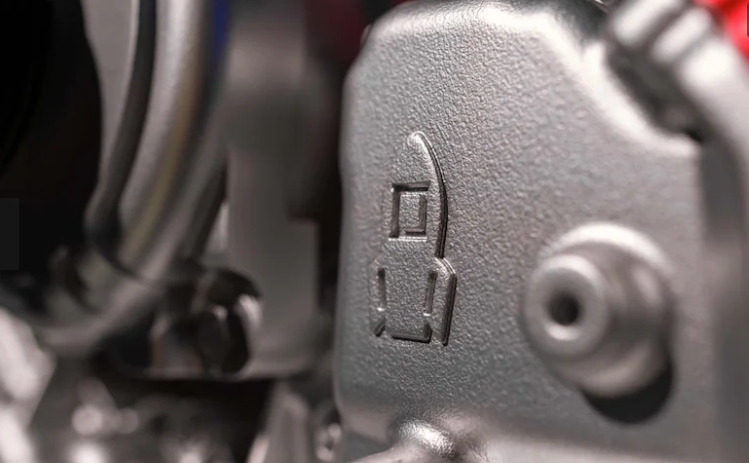
A Flat-Plane Crank
Arguably one of the coolest features of the new Z06 Corvette is the LT6’s flat-plane crankshaft. The introduction of the flat-plane crank transformed the traditional exhaust note of the Corvette into something more akin to a Ferrari or Lamborghini. However, its inclusion also provided a variety of performance benefits including a reduction in weight (the LT6 crank is 33 percent lighter than the crank in the LT2). Less weight literally translates to faster revs as compared to an engine with a cross-plane crankshaft. Additionally, the crank produces a shorter 3.15-inch stroke (80mm) compared to the 3.62-inch stroke (92 mm) found in the LT2 engine. Lastly, the flat-plane design resulted in a modified engine firing order of 1-4-3-8-7-6-5-2.
Titanium Rods and Forged Pistons
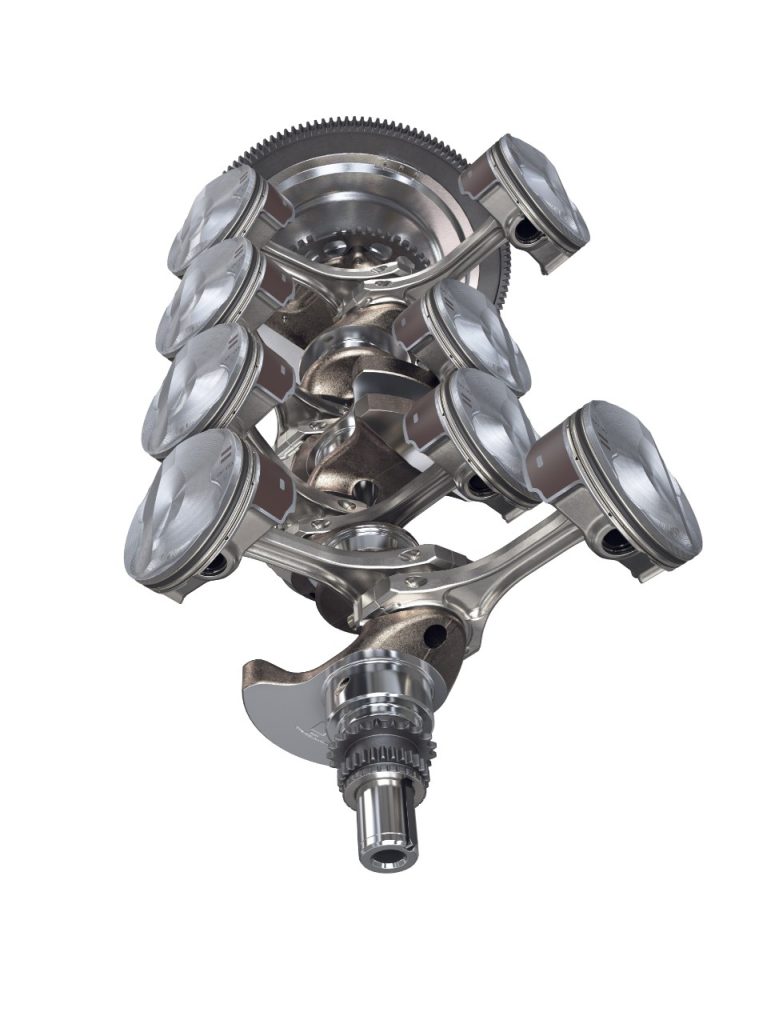
Added weight reduction was an absolute necessity to achieve high engine revs quickly. To accomplish this, Chevrolet incorporated forged-titanium piston connecting rods into the LT6 engine. These rods are 43.4 percent lighter than the rods in the LT4 engine and 21 percent lighter than those used in the 2019 Corvette ZR1’s LS7 engine! Added to this are a set of forged-aluminum pistons with a reduced height of just 47.14mm. As with the connecting rods, these updated pistons are lighter – 18 percent lighter than those used in the LT4 and 8 percent lighter than those found in the LS7. Each piston features rings that are DLC (Diamond Like Carbon) and PVD (Physical Vapor Deposition) coated to ensure efficient travel and unparalleled strength, even during extreme driving conditions. Each set of four pistons is unique in each bank, and both sets were specifically engineered to reduce piston rock. Likewise, the polymer-coated/asymmetric-profile skirts ere designed to reduce friction and wear.
Dual Overhead Cams / Pushrods
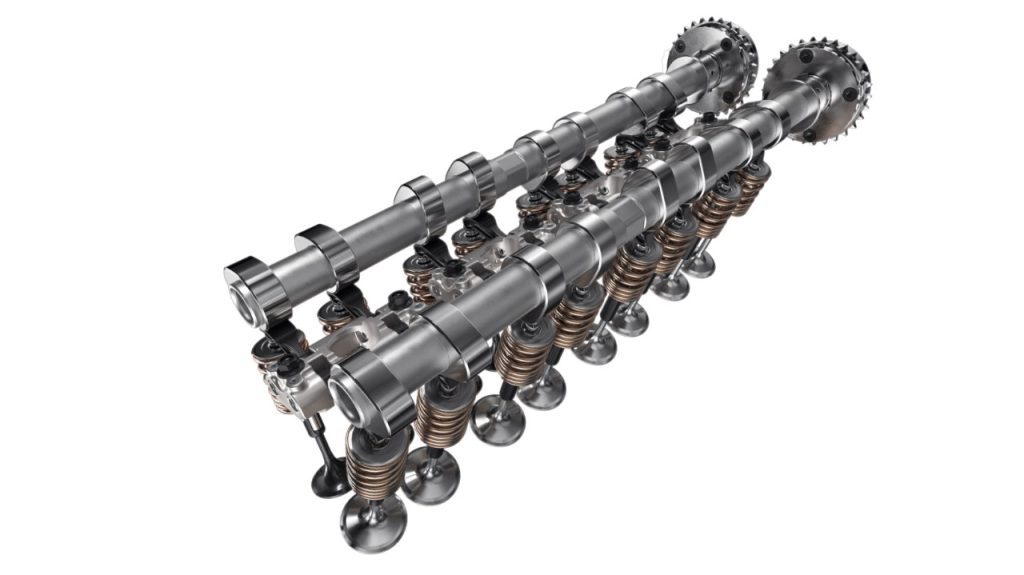
Given the high-revving limits of the DOHC (Dual Overhead Cam) LT6 engine, airflow was a top consideration when developing the engine’s all-new cylinder heads. Both the exhaust port inlets and outlets were machined to assure alignment with the valve seats and produce a smooth transition to the exhaust manifolds for optimal airflow. The cylinder head’s water jackets were optimized to allow larger amounts of coolant to move them and remove as much heat as possible. Each head was rotocast with A356+0.5 Cu with a T6 heat treatment. Moreover, the DOHC system allows the LT5 the ability to move enough air to create combustion even at redline speeds. In fact, the LT6 heads outperform both the LT2 and LS7 engines in terms of overall airflow.
The DOHC system utilizes dual-independent hydraulic cam phasing for optimal torque across the entire powerband/RPM range. It also produces variable overlap for emissions control. The intake has 55 crank degrees of authority while the exhaust valve has 27 crank degrees of authority. Each of the camshafts is hollow for added weight savings, and each feature forged and induction-hardened double-polished lobes.
Valvetrain
The high RPM demands of the LT6 required an alternate solution to a conventional hydraulic valve train. Instead of using a hydraulic system, the LT6 employs a mechanical valve train that utilizes robotically installed high-grade steel lash caps that do not require maintenance. The finger followers are highly polished with a DLC coating, and each has an integrated oil jet for targeted lubrication. Collectively, the mechanical valve train is a rigid design with a minimal moving mass that produces a stable and precise high-speed valve actuation at any speed.
Dry-Sump Oil System
Where the C8 Corvette Stingray’s LT2 engine features an oil pan with an open-by dry-sump system, the LT6 found in the Z06 uses the LCC (lower crankshaft casing along with a sealed bay design to house its oil, thereby eliminating the need for a physical oil pan. In fact, the LT6 has four, individually-sealed crank bays, each of which helps manage/control the oil found beneath that section of the piston and crankshaft assemblies. In that respect, the LCC is, essentially, an oil pan mated to the engine’s main caps. However, given that the system is a dry-sump system, very little of the oil actually resides in the LCC. Regardless, it still houses enough oil to ensure proper lower-end lubrication. An integrated gunslit within the LCC also helps channel oil away from those areas while the all-new, six-stage dry-sump oiling system helps with individual crank bay scavenging.
Additional highlights include:
- All-new aluminum cylinder block casting with the Small Block engine family’s signature 4.4-inch (111.76 mm) bore spacing.
- Dual-coil valve springs to support titanium intake and sodium-filled exhaust valves
- Distinctive Edge Red camshaft covers
- All-new active split intake manifold with twin 87 mm throttle bodies
- Four-into-two-into-one stainless steel exhaust headers
- 670 hp at 8,400 rpm (GM tested per SAE J1349)
- 460 lb-ft (623 Nm) of torque @ 6300 rpm (GM tested per SAE J1349)
Each LT6 engine is hand-assembled by master engine builders at the Performance Build Center within the Bowling Green Assembly Plant in Bowling Green, Kentucky. The builders utilize precision tooling, and each hand-fits pieces of the engine together per Chevrolet’s exact specifications.
Track-Proven Technologies Developed Thru Racing

While the Z06’s LT6 powerplant is certainly representative of the engine platform used by the Corvette Racing program, the similarities between the Z06 and the C8.R race car only begin with the engine. In fact, the Z06 has been already been referred to as a “street-legal Corvette race car.” Both the car’s sound and its appearance take direction from the Corvette Racing program and the direct knowledge transfer between the two cars has never been more evident than it is with this newest Corvette Z06. In fact, the Z06’s chassis is the same as that used by Corvette Racing’s C8.R since its introduction in 2020.
“Racing was the reason the Z06 was developed in 1963, and it continues to support development of the road models that make them better on the street and the track,” said Tadge Juechter, executive chief engineer, Corvette. “It also means we’ve tested the Z06 on the best tracks around the world, from Circuit of the Americas here in the United States, to the Nürburgring in Germany.”
The performance envelope of Z06 was also developed on the foundation laid by the eighth-generation, mid-engine Corvette Stingray. It leveraged many of the same technologies, including the strategic use of lightweight materials and advanced driver technologies, and even the same SLA-type front and rear suspension designs, albeit with unique features and calibrations intended to suit the demands of the Z06’s superior performance capabilities.
Onboard Technologies
Building on the technologies introduced in the 2020 Stingray, the new Z06 provides drivers with an incredible variety of features that enhance the driver’s experience. Magnetic Selective Ride Control (version 4.0) comes standard on every Z06 and can be adjusted for touring comfort or maximum track performance thru the use of the standard Driver Mode Selector (a feature that was first introduced on the seventh-generation Corvette Stingray.)
As with the eighth-generation Stingray, the latest Driver Mode Selectors tailors more than a dozen unique features integrated into the Z06 to suit each driver’s unique experience. These features include the following options:
- Launch Control: Available in Track mode for maximum off-the-line acceleration.
- Active Handling (StabiliTrak Electronic Stability Control): Z06 has performance traction management included as a standard feature.
- Traction Control: Weather mode tailors traction control and engine torque for driving in inclement conditions.
- Performance Traction Management: Available in Track mode and offers five settings of torque reduction and brake intervention for track driving.
- Electronic Limited Slip Differential: Adjusts the rate at which the limited slip engages to balance between steering response and stability in different driving conditions.
Stopping Power & Unparalleled Performance
While the car’s acceleration, handling, cornering, and top-speed leave drivers breathless, the 2023 Corvette Z06’s ability to stop is equally impressive, especially given the car’s potential both on-and-off the racetrack. To increase the car’s breaking capabilities, Chevrolet engineers introduced larger 14.6-inch-diameter (370mm) front and 15-inch-diameter (380mm) rear Brembo brake rotors. Even larger, carbon ceramic brake rotors were developed and included with the Z07 Performance Package. The Z06 also came equipped with six-piston front calipers (as compared to the four-piston calipers found on the Stingray model.)
In terms of performance, the Z06 Performance Package takes everything that’s great about the Z06 and pushes its performance to its zenith. Consumers who purchase the Z07 Performance Package also receive the following features on their cars:
- A carbon fiber aero package with a larger front splitter, front-corner dive planes, a rear wing, and underbody strakes that enhance downforce.
- Unique FE7 suspension with specific Magnetic Ride Control 4.0 calibrations.
- Michelin Sport Cup 2 R ZP tires developed specifically for the Z06.
- Available carbon fiber wheels that deliver a 41-pound (18.6 kg) reduction in unsprung mass.
- Brembo® carbon ceramic brake system featuring larger, 15.7-inch-diameter (398 mm) front rotors and 15.4-inch-diameter (391 mm) rear rotors.
The 2023 Corvette Z06, when equipped with the Z07 performance package in the track-prepared configuration, is capable of an incredible 1.22 g of road-hugging grip within a 300-foot diameter circle.
Everything Else That Separates the Z06 From the Eighth-Generation Stingray
While there’s no denying that the Z07 Performance Package is transformative to the 2023 Corvette Z06, its absence on the car does not marginalize the vehicle, especially compared to its base model counterpart. As stated previously, the Z06 does share some of the same components as the Stingray, but these inclusions also afforded GM’s designers and engineers to create both coupe and convertible models of the brand’s premier performance model. Because of the robust architecture developed on the Stingray, the 2023 Corvette Z06 was offered to consumers with a hardtop convertible option. What’s most amazing about this option is that there is no variance in structural rigidity or in suspension calibrations between the convertible and coupe variants.
And while these elements, along with the Z06’s overall aesthetic, certainly harken to the eighth-generation Stingray’s overall design and aesthetic, there are still a number of significant highlights/differentiators between the two cars that become readily evident when the pair are parked side-by-side.
The unique styling found on the 2023 Corvette Z06 includes a wider stance (3.6 inches / 9.4 cm) designed to accommodate the massive 345-series rear tires developed for the car and to allow more airflow through the larger side air vents, unique front and rear fascias specifically developed for the Z06 and designed to optimize the Z06’s cooling needs, including channeling air to a center heat exchanger, which is one of five such devices installed on the car for maximum cooling performance.
Additional features unique to the 2023 Corvette Z06 include:
- A unique, standard reconfigurable rear spoiler with adjustable wicker bill elements designed to improve high-speed stability and cornering capability on a racetrack.
- Standard 20-inch front and 21-inch rear forged aluminum “spider” wheels (with five available finishes) — the largest wheels ever available on a production Corvette.
- Available lightweight and rigid carbon fiber wheels that deliver a 41-pound (18.6-kg) reduction in unsprung mass, which contributes to more agile and responsive handling.
- Specific suspension tuning, including Magnetic Ride Control 4.0, and larger brakes (six-piston front) than the Stingray, contribute to making the 2023 Corvette Z06 the most track-capable Corvette ever.
- An eight-speed dual-clutch transmission with a specific, “shorter” 5.56 final drive ratio (compared to the final ratio included on the Corvette Stingray,) specifically designed to improve acceleration capability.
- An elevated cockpit that surrounds the driver, with rich materials and textures, including more carbon fiber trim and new options that are unique to the Z06.
- Available Z07 performance package that offers the greatest track capability in any Corvette, EVER, and provides 734 pounds of downforce at 186 mph, more than any Corvette in the history of the brand. It includes a carbon fiber high rear wing and ground effects, specific chassis tuning, specific Magnetic Ride Control calibration, and unique Michelin® Cup 2 R ZP tires, along with Brembo® carbon ceramic brakes and optional carbon fiber wheels.
“Virtually every component that distinguishes the Z06 was developed to support or enhance its capability,” said Juechter. “By leveraging the mid-engine architecture’s inherent advantages, we are able to achieve six percent more downforce than a seventh-gen ZR1 at eight percent lower drag.”
Performance and Pricing
To fully appreciate the 2023 Corvette Z06, one need only drive it, right? As the car is still brand new to the market, and as it may be prohibitively expensive for some consumers, especially those who don’t have a spare $100k to spend on a purpose-built sports car, affordability and availability may come into question. For those that either can’t get their hands on one because of availability, or don’t have the bank right now to invest in one, its still worth taking a moment to drool over some of the published performance numbers being delivered by this car.
To start, the car can do zero to 60 in just 2.6 seconds….let that sink in, 2.6 SECONDS! That’s freaking fast! Almost as impressive is the car’s stopping power. The Z06, when equipped with the upgraded Z07 braking system, can do a 60 to zero stop in just 95 feet! Of course, these are just the numbers being published by GM. One might wonder if these claims are more robust than accurate – GM is trying to sell a super car version of their Corvette, right? WRONG. As demonstrated on multiple YouTube channels since the car was introduced in fall of 2022, the new 2023 Corvette Z06 has a 0-60 time of just 2.2 seconds and a quarter-mile time of 10.5 seconds. Folks, that’s FAST.
As for top speed? Well, early reports have claims ranging from 195-200 miles per hour, but as the car gets more track time and as drivers have opportunities to push its boundaries, that number is likely to change. We’ll update this information when it does.
Of course, those kinds of performance numbers don’t come cheap, which makes it a little surprising when we look at the pricepoint for the new 2023 Corvette Z06. As stated a moment ago, this car is priced in an area that is probably out of reach for many, but having said that, its still a comparable bargain when compared to European sports cars that can put up similar numbers on the track (or the road.)
With an MSRP of $106,695 for the coupe and $114,195 for the convertible, the 2023 Corvette Z06 may be one of the most amazing deals on the market today for a car that can deliver top-tier, supercar-level performance. It is important to keep in mind that these numbers reflect base-level pricing without any of the many desirable options thrown in (including upgraded trim packages, technology packages, the Z07 Performance package, etc.) Those items quickly send the pricepoint climbing even further, with fully equipped 2023 Corvette Z06 models selling for north of $140,000 (at the time of this publication). Additionally, supply and demand come into play here, and there have already been reports of dealers asking considerably more for the 2023 Z06s in their showrooms than the published MSRP shows on the attached window stickers.



